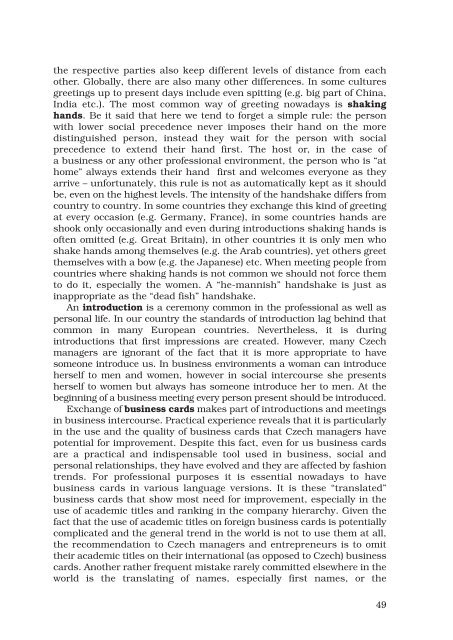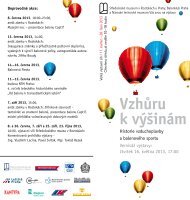Sestava 1 - Vysoká škola obchodnà v Praze
Sestava 1 - Vysoká škola obchodnà v Praze
Sestava 1 - Vysoká škola obchodnà v Praze
You also want an ePaper? Increase the reach of your titles
YUMPU automatically turns print PDFs into web optimized ePapers that Google loves.
the respective parties also keep different levels of distance from each<br />
other. Globally, there are also many other differences. In some cultures<br />
greetings up to present days include even spitting (e.g. big part of China,<br />
India etc.). The most common way of greeting nowadays is shaking<br />
hands. Be it said that here we tend to forget a simple rule: the person<br />
with lower social precedence never imposes their hand on the more<br />
distinguished person, instead they wait for the person with social<br />
precedence to extend their hand first. The host or, in the case of<br />
a business or any other professional environment, the person who is “at<br />
home” always extends their hand first and welcomes everyone as they<br />
arrive – unfortunately, this rule is not as automatically kept as it should<br />
be, even on the highest levels. The intensity of the handshake differs from<br />
country to country. In some countries they exchange this kind of greeting<br />
at every occasion (e.g. Germany, France), in some countries hands are<br />
shook only occasionally and even during introductions shaking hands is<br />
often omitted (e.g. Great Britain), in other countries it is only men who<br />
shake hands among themselves (e.g. the Arab countries), yet others greet<br />
themselves with a bow (e.g. the Japanese) etc. When meeting people from<br />
countries where shaking hands is not common we should not force them<br />
to do it, especially the women. A “he-mannish” handshake is just as<br />
inappropriate as the “dead fish” handshake.<br />
An introduction is a ceremony common in the professional as well as<br />
personal life. In our country the standards of introduction lag behind that<br />
common in many European countries. Nevertheless, it is during<br />
introductions that first impressions are created. However, many Czech<br />
managers are ignorant of the fact that it is more appropriate to have<br />
someone introduce us. In business environments a woman can introduce<br />
herself to men and women, however in social intercourse she presents<br />
herself to women but always has someone introduce her to men. At the<br />
beginning of a business meeting every person present should be introduced.<br />
Exchange of business cards makes part of introductions and meetings<br />
in business intercourse. Practical experience reveals that it is particularly<br />
in the use and the quality of business cards that Czech managers have<br />
potential for improvement. Despite this fact, even for us business cards<br />
are a practical and indispensable tool used in business, social and<br />
personal relationships, they have evolved and they are affected by fashion<br />
trends. For professional purposes it is essential nowadays to have<br />
business cards in various language versions. It is these “translated”<br />
business cards that show most need for improvement, especially in the<br />
use of academic titles and ranking in the company hierarchy. Given the<br />
fact that the use of academic titles on foreign business cards is potentially<br />
complicated and the general trend in the world is not to use them at all,<br />
the recommendation to Czech managers and entrepreneurs is to omit<br />
their academic titles on their international (as opposed to Czech) business<br />
cards. Another rather frequent mistake rarely committed elsewhere in the<br />
world is the translating of names, especially first names, or the<br />
49










